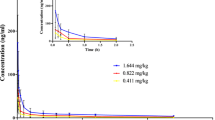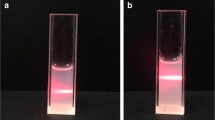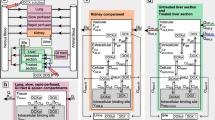Abstract
Purpose
To simulate the stimuli-responsive and stoichiometrically controlled doxorubicin (DOX) release from liposomes in in vivo tumor interstitial fluid (TIF), the effect of ammonia concentration and pH on the DOX release from liposomes in human plasma at 37°C was quantitatively evaluated in vitro and the release rate was calculated as a function of ammonia concentration and pH.
Methods
Human plasma samples spiked with DOX-loaded PEGylated liposomes (PLD) or Doxil®, containing ammonia (0.3–50 mM) at different pH values, were incubated at 37°C for 24 h. After incubation, the concentration of encapsulated DOX in the samples was determined by validated solid-phase extraction (SPE)-SPE-high performance liquid chromatography.
Results
Accelerated DOX release (%) from liposomes was observed as the increase of ammonia concentration and pH of the matrix, and the decrease of encapsulated DOX concentration. The release rate was expressed as a function of the ammonia concentration and pH by using Henderson-Hasselbalch equation.
Conclusions
The DOX release from PLD in TIF was expressed as a function ammonia concentration and pH at various DOX concentrations. Further, it was found that the DOX release from liposomes in a simulated TIF was more than 15 times higher than in normal plasma.







Similar content being viewed by others
Abbreviations
- DDS:
-
Drug delivery system
- DOX :
-
Doxorubicin
- FLD:
-
Fluorescence detection
- HPLC:
-
High performance liquid chromatography
- HSPC:
-
Hydrogenated soy phosphatidylcholine
- IVIVC:
-
In vitro and in vivo correlation
- MPEG2000-DSPE:
-
N-(Carbonyl-methoxypolyethyleneglycol-2000)-1,2-distearoyl-sn-glycero-3-phosphoethanolamine
- PLD :
-
PEGylated liposomal doxorubicin
- SPE :
-
Solid-phase extraction
- TIF:
-
Tumor interstitial fluid
- UV:
-
Ultravioletcorrelation
References
Bobo D, Robinson KJ, Islam J, Thurecht KJ, Corrie SR. Nanoparticle-based medicines: a review of FDA-approved materials and clinical trials to date. Pharm Res. 2016;33(10):2373–87.
Barenholz Y. Doxil® — the first FDA-approved nano-drug: lessons learned. J Control Release. 2012;160(2):117–34.
Asai T. Nanoparticle-mediated delivery of anticancer agents to tumor Angiogenic vessels. Biol Pharm Bull. 2012;35(11):1855–61.
Yang M, Lai SK, Wang Y-Y, Zhong W, Happe C, Zhang M, et al. Biodegradable nanoparticles composed entirely of safe materials that rapidly penetrate human mucus. Angew Chem Int Ed. 2011;50(11):2597–600.
Silverman L, Barenholz Y. In vitro experiments showing enhanced release of doxorubicin from Doxil® in the presence of ammonia may explain drug release at tumor site. Nanomedicine. 2015;11(7):1841–50.
Mariño G, Kroemer G. Ammonia: a diffusible factor released by proliferating cells that induces autophagy. Sci Signal. 2010;3(124):pe19.
Eng CH, Yu K, Lucas J, White E, Abraham RT. Ammonia Derived from Glutaminolysis Is a Diffusible Regulator of Autophagy. Science Signaling. 2010;3(119):ra31–1.
Gabizon A, Martin F. Polyethylene glycol-coated (Pegylated) liposomal doxorubicin. Drugs. 2012;54(4):15–21.
Maurer N, Wong KF, Hope MJ, Cullis PR. Anomalous solubility behavior of the antibiotic ciprofloxacin encapsulated in liposomes: a 1H-NMR study. Biochim Biophys Acta. 1998;1374(1–2):9–20.
Nakamura K, Yoshino K, Yamashita K, Kasukawa H. Designing a novel in vitro drug-release-testing method for liposomes prepared by pH-gradient method. Int J Pharm. 2012;430(1–2):381–7.
Zhigaltsev IV, Maurer N, Edwards K, Karlsson G, Cullis PR. Formation of drug–arylsulfonate complexes inside liposomes: a novel approach to improve drug retention. J Control Release. 2006;110(2):378–86.
Fugit KD, Xiang T-X, Choi DH, Kangarlou S, Csuhai E, Bummer PM, et al. Mechanistic model and analysis of doxorubicin release from liposomal formulations. J Control Release. 2015;217:82–91.
Csuhai E, Kangarlou S, Xiang T-X, Ponta A, Bummer P, Choi D, et al. Determination of key parameters for a mechanism-based model to predict doxorubicin release from actively loaded liposomes. J Pharm Sci. 2015;104(3):1087–98.
Gaber MH, Hong K, Huang SK, Papahadjopoulos D. Thermosensitive sterically stabilized liposomes: formulation and in vitro studies on mechanism of doxorubicin release by bovine serum and human plasma. Pharm Res. 1995;12(10):1407–16.
Shibata H, Izutsu K-i, Yomota C, Okuda H, Goda Y. Investigation of factors affecting in vitro doxorubicin release from PEGylated liposomal doxorubicin for the development of in vitro release testing conditions. Drug Dev Ind Pharm. 2015;41(8):1376–86.
Yuan W, Kuai R, Dai Z, Yuan Y, Zheng N, Jiang W, et al. Development of a flow-through USP-4 apparatus drug release assay to evaluate doxorubicin liposomes. AAPS J. 2016:1–11.
Snyder EL, Judge J. Plasma. In: Delves PJ, editor. Encyclopedia of immunology (Second Edition). Oxford: Elsevier; 1998. p. 1964–9.
Anchordoquy TJ, Barenholz Y, Boraschi D, Chorny M, Decuzzi P, Dobrovolskaia MA, et al. Mechanisms and barriers in cancer nanomedicine: addressing challenges, looking for solutions. ACS Nano. 2017;11(1):12–8.
Yamamoto E, Hyodo K, Ohnishi N, Suzuki T, Ishihara H, Kikuchi H, et al. Direct, simultaneous measurement of liposome-encapsulated and released drugs in plasma by on-line SPE–SPE–HPLC. J Chromatogr B Anal Technol Biomed Life Sci. 2011;879(30):3620–5.
Wibroe PP, Ahmadvand D, Oghabian MA, Yaghmur A, Moghimi SM. An integrated assessment of morphology, size, and complement activation of the PEGylated liposomal doxorubicin products Doxil®, Caelyx®, DOXOrubicin, and SinaDoxosome. J Control Release. 2016;221:1–8.
Schilt Y, Berman T, Wei X, Barenholz Y, Raviv U. Using solution X-ray scattering to determine the high-resolution structure and morphology of PEGylated liposomal doxorubicin nanodrugs. Biochim Biophys Acta Gen Subj. 2016;1860(1:108–19.
Itoh N, Kimoto A, Yamamoto E, Higashi T, Santa T, Funatsu T, et al. High performance liquid chromatography analysis of 100-nm liposomal nanoparticles using polymer-coated, silica monolithic columns with aqueous mobile phase. J Chromatogr A. 2017;1484:34–40.
Howanitz JH, Howanitz PJ, Skrodzki CA, Iwanski JA. Influences of specimen processing and storage conditions on results for plasma ammonia. Clin Chem. 1984;30(6):906–8.
Fugit KD, Jyoti A, Upreti M, Anderson BD. Insights into accelerated liposomal release of topotecan in plasma monitored by a non-invasive fluorescence spectroscopic method. J Control Release. 2015;197:10–9.
Olofsson G. Thermodynamic quantities for the dissociation of the ammonium ion and for the ionization of aqueous ammonia over a wide temperature range. J Chem Therm. 1975;7(6):507–14.
Rhee JG, Kim TH, Levitt SH, Song CW. Changes in acidity of mouse tumor by hyperthermia. Int J Radiat Oncol Biol Phys. 1984;10(3):393–9.
Wiig H, Tenstad O, Iversen PO, Kalluri R, Bjerkvig R. Interstitial fluid: the overlooked component of the tumor microenvironment. Fibrogenesis Tissue Repair. 2010;3:12.
Jiang W, Lionberger R, Yu LX. In vitro and in vivo characterizations of PEGylated liposomal doxorubicin. Bioanalysis. 2011;3(3):333–44.
Gref R, Luck M, Quellec P, Marchand M, Dellacherie E, Harnisch S, et al. 'Stealth' corona-core nanoparticles surface modified by polyethylene glycol (PEG): influences of the corona (PEG chain length and surface density) and of the core composition on phagocytic uptake and plasma protein adsorption. Colloids Surf, B. 2000;18:301–13.
Andriyanov AV, Koren E, Barenholz Y, Goldberg SN. Therapeutic efficacy of combining PEGylated liposomal doxorubicin and radiofrequency (RF) ablation: comparison between slow-drug-releasing, non-thermosensitive and fast-drug-releasing, thermosensitive Nano-liposomes. PLoS One. 2014;9(5):e92555.
Gabizon A, Catane R, Uziely B, Kaufman B, Safra T, Cohen R, et al. Prolonged circulation time and enhanced accumulation in malignant exudates of doxorubicin encapsulated in polyethylene-glycol coated liposomes. Cancer Res. 1994;54(4):987–92.
Jain RK, Shah SA, Finney PL. Continuous noninvasive monitoring of pH and temperature in rat Walker 256 carcinoma during Normoglycemia and hyperglycemia. J Natl Cancer Inst. 1984;73(2):429–36.
Stohrer M, Boucher Y, Stangassinger M, Jain RK. Oncotic pressure in solid tumors is elevated. Cancer Res. 2000;60(15):4251–5.
O'Brien M, Wigler N, Inbar M, Rosso R, Grischke E, Santoro A, et al. Breast cancer study group: reduced cardiotoxicity and comparable efficacy in a phase III trial of pegylated liposomal doxorubicin HCl (CAELYX/Doxil) versus conventional doxorubicin for first-line treatment of metastatic breast cancer. Ann Oncol. 2004;15(3):440–9.
Petersen GH, Alzghari SK, Chee W, Sankari SS, La-Beck NM. Meta-analysis of clinical and preclinical studies comparing the anticancer efficacy of liposomal versus conventional non-liposomal doxorubicin. J Control Release. 2016;232(Supplement C):255–64.
Shi J, Kantoff PW, Wooster R, Farokhzad OC. Cancer nanomedicine: progress, challenges and opportunities. Nat Rev Cancer. 2017;17(1):20–37.
Schellekens H, Klinger E, Mühlebach S, Brin J-F, Storm G, Crommelin DJA. The therapeutic equivalence of complex drugs. Regul Toxicol Pharmacol. 2011;59(1):176–83.
Schellekens H, Stegemann S, Weinstein V, Vlieger JSB, Flühmann B, Mühlebach S, et al. How to regulate nonbiological complex drugs (NBCD) and their follow-on versions: points to consider. AAPS J. 2013;16(1):15–21.
Author information
Authors and Affiliations
Corresponding author
Rights and permissions
About this article
Cite this article
Yamamoto, E., Hyodo, K., Suzuki, T. et al. Simulation of Stimuli-Responsive and Stoichiometrically Controlled Release Rate of Doxorubicin from Liposomes in Tumor Interstitial Fluid. Pharm Res 35, 103 (2018). https://doi.org/10.1007/s11095-018-2380-y
Received:
Accepted:
Published:
DOI: https://doi.org/10.1007/s11095-018-2380-y




